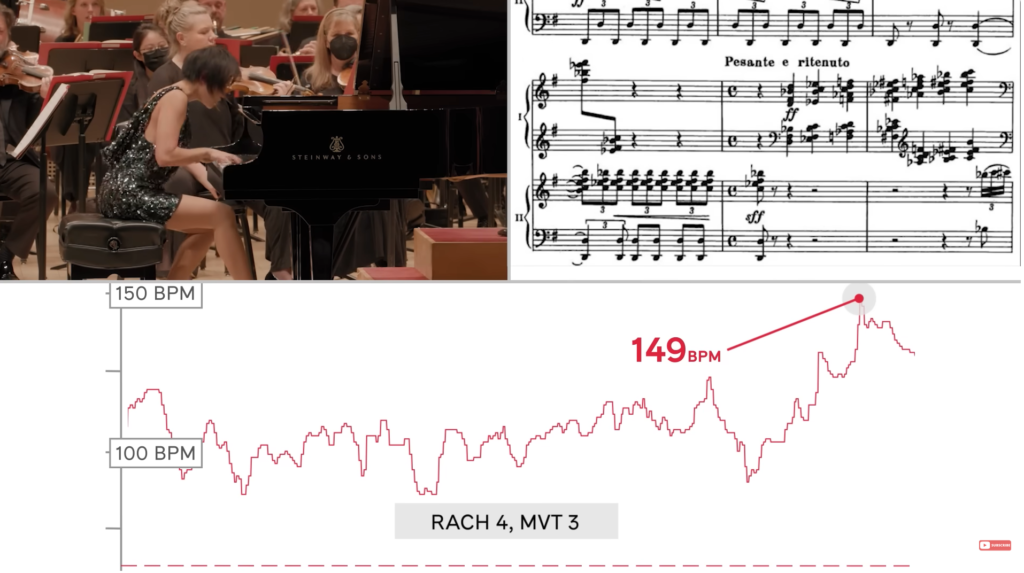Does Rachmaninoff Touch Your Heart?
Today, with smartwatches and everyday electronics, it is increasingly common to measure training results, heart rate, calorie consumption, and overall health. But monitoring heart rate of pianists and audience can reveal interesting insights on several other aspects within the musical field.
We have previously written about Dr. Riley, who uses body scanning and heart rate to improve musicians’ playing, performance and self-consciousness.
Researcher Wolfgang Tschacher has also worked on measuring synchronicity between music performances and audiences through heart rate measurements and has recently published his results in the scientific magazine Nature. Tschacher’s results indicate that individuals in an audience may synchronize their breathing patterns, perspiration rates, and even movements in their seats while collectively experiencing a classical music concert.
Scanning Yuja Wang During Rachmaninoff Marathon

As part of last year’s Rachmaninoff 150 celebrations, pianist Yuja Wang made headlines after a 2.5-hour Carnegie Hall performance featuring Rachmaninoff’s all four piano concertos and the Rhapsody on a Theme of Paganini in January 2023. Wang, alongside conductor Yannick Nézet-Séguin and the Philadelphia Orchestra, delivered a most challenging program, first-time-ever done, according to Wang.
Continuously, Rachmaninoff’s music enchants audiences like no other, and the artists aimed to explore a central question: How does Rachmaninoff’s music affect your heart rate?
Carnegie Hall decided to make an experiment to investigate it based on the impressive effort of the occasion: During the performance, Wang performed over 97,000 notes, equivalent to 621 pages of music and 2.5 hours of playing time. Throughout the concert, she burned 2,427 calories, equivalent to 20,275 steps. In contrast, Nézet-Séguin burned 1,645 calories, or 15,079 steps.
One particularly intriguing aspect was Wang’s ability to identify key musical moments by analyzing her heart rate graph. She noted spikes in her heart rate during intense passages like the jumps in the Rhapsody but also moments where her heart rate remained surprisingly low despite the demanding music.
Wang mentioned that her heart rate tended to surge during climactic sections with more notes, showing a clear correlation between the music’s intensity and her physiological response. However, her deep familiarity with Piano Concerto No.3 seemed to induce a sense of calmness, reflected in her notably relaxed heart rate during this piece.
Orchestra and Audience Too
Multiple orchestra members and audience members also wore heart monitors to track their heart rates throughout the performance. The results revealed fascinating insights, from the highest to the lowest heart rates and moments of synchronized heartbeats among the performers.
Connecting Musically
The study also revealed instances of synchronized heart rates between Wang and Nézet-Séguin, highlighting their profound musical connection. These moments of harmony in heartbeats emphasized the emotional and intellectual bond that music creates, transcending mere notes to create a shared “telepathic” union.
In essence, Carnegie Hall’s experiment with a heart monitoring device offered a unique perspective on the intersection of music, emotion, and physiology, showcasing the complex interplay between a performer’s physical and emotional responses during a live concert.
Watch the video in which Carnegie Hall presents the results of the experiment:
Related reading:
Body and Intention – Tracking Down Musicians’ Health
Audience synchronies in live concerts illustrate the embodiment of music experience
Digital piano sheet music – Rachmaninoff Piano Concertos:





Comments